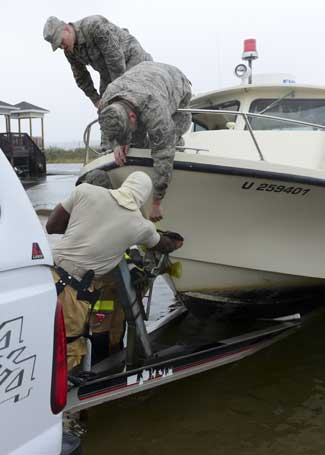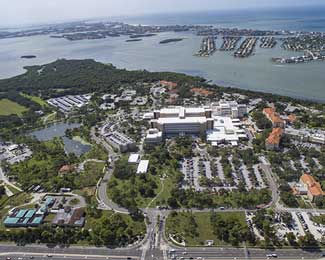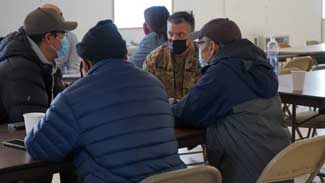VA Hospitals Vulnerable to Extreme Weather as Climate Changes, Report Finds
On July 19, 2022, a soupy, relentless heat smothered Muskogee, Oklahoma. By four in the afternoon, the temperature spiked to 106 degrees. While the weather wasn’t completely unheard of, researchers say extreme heat events like this will only grow more commonplace in Muskogee and elsewhere.
The heat index—how the temperature feels to the human body—hit 100 degrees in Muskogee an average of 29 days per year between 1971 and 2000. By the end of this century, that could climb to 200 days a year, according to research from the Union of Concerned Scientists. Muskogee isn’t alone; other areas of Oklahoma, along with Texas, Arizona, Louisiana, and Florida, could experience the same regularity of sweltering heat, the research shows.
At the Jack C. Montgomery VA Medical Center in Muskogee, the last two summers have overtaxed the chillers used to cool the 100-year-old facility. Larry Jackson, the chief of safety and emergency management program services at the Eastern Oklahoma VA Health Care System, says when the chillers failed, he had to prioritize placing air conditioning in parts of the facility with inpatient beds, rather than the outpatient clinics. An upgrade to the entire HVAC system is underway.

A photo of the VA hospital in Muskogee, Oklahoma, circa 1924. Photo courtesy of the Department of Veterans Affairs.
“Seventy percent of that work is completed, along with a backup air cooling chiller,” he says.
Extreme heat is not the only climate change-related threat to Muskogee and the VA Medical Center located there. Severe storms will also likely intensify in Oklahoma and other Midwestern and Plains states, leaving a number of VA buildings and employees vulnerable, according to a recent Veterans Affairs Climate Vulnerability Assessment Report.
The report, completed last fall, came one month after the Intergovernmental Panel on Climate Change issued its 2023 report indicating that human activities—primarily the emissions of greenhouse gases—are leading to weather extremes and that the global average temperature will likely rise to 1.5 degrees Celsius (2.7 degrees Fahrenheit) above preindustrial levels by the 2030s. If it continues to climb higher, scientists expect catastrophic flooding, heat, drought, and other disasters.
Knowing what’s ahead, Veterans Affairs, which serves more than nine million veterans and employs more people than any other health care system in the U.S.—371,000—recently assessed its infrastructure to figure out which medical centers, hospitals, and cemeteries are most likely to get hit by climate-related disasters. It’s a first step in figuring out how best to prepare.
The report found that certain regions, including Kansas and Florida, may get hit by multiple different extreme weather events related to climate change. This could put clinics and hospitals at risk for power outages or roof leaks or rerouted ER arrivals—and if patients and staff can’t access facilities, the care of veterans could suffer.
“Impacts that will happen from [unpredictable weather extremes] will include lost time, canceled appointments … slips, falls, even accidents on the roadways going to (and) from work and home,” says a VA employee quoted in the report.
‘The Same Level of Stress Is Not Felt by All People’
Last year marked the world’s hottest year on record, and the United States experienced an unprecedented number of billion-dollar disasters, according to the National Oceanic and Atmospheric Administration: 28 total, including 17 severe hail and weather events, four floods, and two tornado outbreaks.
Destructive weather anomalies have unfolded repeatedly over the last several years. In 2015, severe wind and precipitation damaged the Phoenix VA Medical Center, causing multiple hospital rooms to close and a halt on new patient admissions. Incoming emergency room patients were transferred to nearby hospitals and scheduled procedures were delayed. The facility’s flood water damage also created the potential for hazardous mold and bacteria growth, human infection, and water supply contamination.
In 2021, VA adopted a climate action plan that included revamping the climate resilience requirements used when selecting sites for new facilities, as well as making sure they have the necessary stockpiles of supplies to respond to potential infections and diseases.
For the vulnerability assessment of VA infrastructure, VA analyzed 171 hospitals and clinics for physical exposure risk to natural disasters, including floods, extreme heat, wildfire, and hurricanes. When scoring each facility on a scale of one to five—five being the highest vulnerability—researchers factored in a facility’s ability to respond to disaster with existing backup water and power supplies, as well as the resilience of the community it serves.

Airmen tow a boat away from the Langley Marina at Langley Air Force Base, Virginia, in October 2015. Heavy precipitation, high winds, storm surges, and flooding associated with Hurricane Joaquin caused personnel to take action. Photo by Airman 1st Class Derek Seifert, courtesy of the U.S. Air Force.
This “social vulnerability” piece of the score looked at socioeconomic status, race, age, and other factors that may cause long-term struggles and health problems for a community hard-hit by disaster.
Tom Ellison, deputy director of the Center for Climate and Security, says it’s “heartening” that VA isn’t just analyzing how changing weather patterns will damage facilities, but also the “broader impact on the communities that the VA is serving.”
Research shows that “anywhere you look with climate impacts the same level of stress is not felt by all people,” he says. “It’s always that the hardest hit people (are) in more marginalized or vulnerable situations,” whether that’s due to low incomes, underlying health conditions, or age.
Nearly a quarter of Muskogee’s residents live in poverty. And in Bay Pines, Florida, a community with a significantly older population, about 16% of the residents are veterans.
Overall, the report showed that more than half of VA medical centers were moderately or highly exposed to extreme precipitation and flooding, 62% to extreme heat, 61% to winter weather, 65% to severe weather like hail and high winds, 38% to hurricanes, and 49% to droughts and wildfires.
Facilities in the Northeast, and particularly upstate New York, are more susceptible to winter weather, while those in the Southwest are more exposed to extreme heat. Not surprisingly, VA hospitals in Florida and Louisiana are ranked as among the most likely to face the lashing hurricanes scientists predict will intensify.
‘Tornados and Winter Storms Are Becoming More Frequent’
Of the 46 cemeteries measured for exposure to climate risks—flooding, lightning, wildfire—none received a score of five, though Fort Leavenworth National Cemetery in Kansas, Jacksonville National Cemetery in Florida, and Fort Sill National Cemetery in Oklahoma ranked as most at risk for climate change-related damages.
Cemeteries, of course, are more static and isolated than the bustle of a hospital. Damage isn’t experienced, but rather discovered in the aftermath.
In the assessment report, VA staff talked about how they regularly witness climate change impacts at their workplace.
Award-Winning Journalism in Your Inbox
One anonymous comment reads, “Our facility is 100 years old and needs to be updated. … Constant leaks and roofing issues are a growing concern.”
Another states, “Tornadoes and winter storms are becoming more frequent and last longer durations.” That commenter requested generators to avoid sudden blackouts during severe weather.
Ellison, deputy director of the Center for Climate and Security, says it’s proactive to harden infrastructure so it can endure what climate change brings. Still, that won’t ensure that VA—or any health care system for that matter—can continue to care for patients uninterrupted.

The Bay Pines VA Healthcare System serves veterans from a 10-county area in the Gulf region of Florida. It is listed as a VA facility at risk for increased hurricane damage due to climate change. Photo by Timothy Westmorland, courtesy of the Bay Pines VA Healthcare System.
“It is a problem of interdependent systems. Climate change has all these direct and indirect effects on the systems that we kind of depend on working well together to form societies to function right,” he says, adding that when disaster strikes, “It’s not just about their impact on water, transportation, it’s about how all these things interact with each other.”
Ellison says the VA assessment doesn’t take into account how hazards might overlap. Hospitals in Oklahoma and Kansas show up as incredibly vulnerable to both severe weather events—hail, wind, tornadoes—and heat. He says those disasters can occur in close succession. “And that’s a real challenge,” he says.
This assessment is only the beginning of determining which VA sites are most vulnerable, a VA spokesperson says, adding that “more site-specific research is likely needed before critical projects can be identified.”
‘We Are Still Dangerously Off Track’
The health care sector is responsible for an estimated 4.5% of global greenhouse gas emissions, and in the United States, that percentage rises to 8.5%. As The War Horse has reported, the military is also a major producer of greenhouse gas emissions, though there’s no reporting requirement.

Maj. Gen. Torrence Saxe, commissioner for the Department of Military and Veterans Affairs and adjutant general of the Alaska National Guard, speaks with Chevak community members prior to a town hall meeting held at the Chevak City Office. Members of the Alaska Department of Military and Veterans Affairs, the Department of Environmental Conservation, and the Department of Commerce, Community, and Economic Development met with tribal leaders and citizens to discuss disaster assistance and processes in light of emergencies in the region, and in preparation for the upcoming flood season. Photo by Dana Rosso, courtesy of the Alaska National Guard.
Recent news reports indicate several military installations are at risk for damage from rising sea levels and storms, including Camp Lejeune in North Carolina and Naval Station Norfolk.
“The science shows that we just aren’t reducing heat-trapping emissions at a global level fast enough,” says Shana Udvardy, senior climate resilience policy analyst with the Union of Concerned Scientists. “We’ve made some progress over the last few years. We are still dangerously off track in terms of closing this gap between the amount of emissions we need to reduce and where we are right now.”
VA and all health care facilities can take “simple” steps to reduce energy use, such as painting their roofs white to reduce the amount of heat in buildings. “They can plant trees for more shade,” she says.
Veterans Affairs has spent over a billion dollars upgrading facilities to become more energy and water-efficient, and VA says its facilities use less energy than the national average for hospitals.
Facilities in Erie, Minneapolis, and other cities have received awards for their sustainability efforts.
Our Journalism Depends on Your Support
In Muskogee, Jackson says his hospital faces unique challenges that go beyond outdated HVAC systems. The building sits on top of a hill with parking at the base. On icy days, the hill can become slick and dangerous. And on extremely hot days, the blacktop parking lot exhales heat. Jackson has expanded shuttle service to keep staff and veterans out of the elements when arriving or leaving the hospital, and he’s acquired backup generators and even two climate-controlled tents to deploy should bad weather cause the main facility to be unusable.
He strives to keep the Jack C. Montgomery VA Medical Center safe and functioning, a task that’s far different than when it first opened, he says.
“When this facility was built in 1923, we’re coming out of our first World War,” he says. “Probably at that time, we were not looking for what it would be [like] 100 years later.”
This War Horse story was reported by Anne Marshall-Chalmers, edited by Kelly Kennedy, fact-checked by Jess Rohan, and copy-edited by Mitchell Hansen-Dewar. Abbie Bennett wrote the headlines.
Coverage of veterans’ health made possible in part by a grant from the A-Mark Foundation.





Comments are closed.